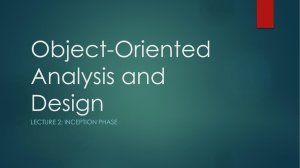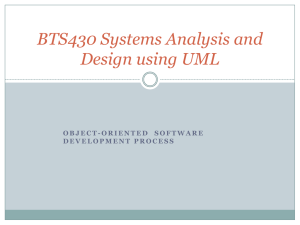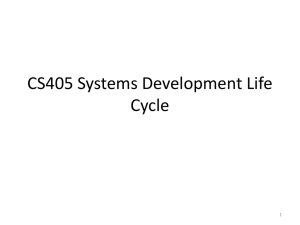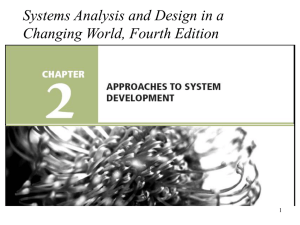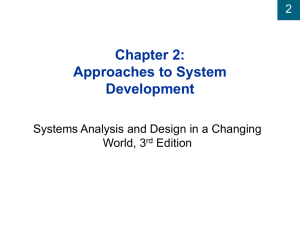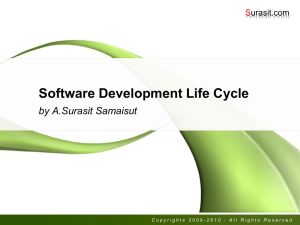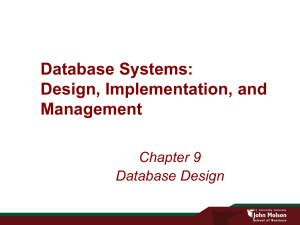Chapter 2
advertisement
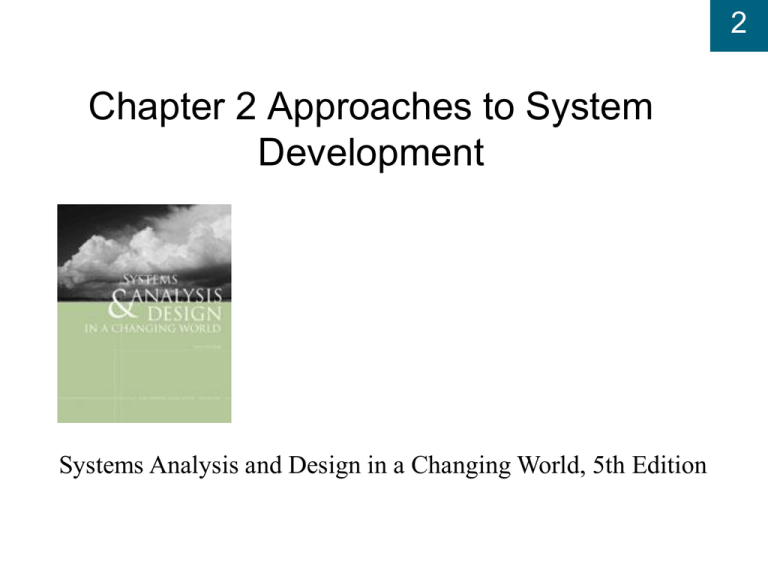
2 Chapter 2 Approaches to System Development Systems Analysis and Design in a Changing World, 5th Edition 2 Learning Objectives Explain the purpose and various phases of the systems development life cycle (SDLC) Explain when to use an adaptive approach to the SDLC in place of a more predictive traditional SDLC Explain the differences between a model, a tool, a technique, and a methodology Describe the two overall approaches used to develop information systems: the traditional method and the object-oriented method Describe the key features of current trends in systems development: the Unified Process (UP), Extreme Programming (XP), and Scrum Explain how automated tools are used in system development 2 2 Overview System development project Planned undertaking with fixed beginning and end Produces desired result or product Can be a large job with thousands of hours of effort or a small one-month project 3 2 The Systems Development Lifecycle Systems development life cycle (SDLC) Two main approaches to SDLC Provides overall framework for managing systems development process Predictive approach – assumes project can be planned out in advance Adaptive approach – more flexible, assumes project cannot be planned out in advance All projects use some variation of SDLC 4 Choosing the Predictive vs. Adaptive Approach to the SDLC 2 Figure 2-1 5 2 Traditional Predictive Approach to the SDLC Project planning – initiate, ensure feasibility, plan schedule, obtain approval for project Analysis – understand business needs and processing requirements Design – define solution system based on requirements and analysis decisions Implementation – construct, test, train users, and install new system Support – keep system running and improve 6 2 SDLC and Problem Solving Similar to problem-solving approach in Chapter 1 Organization recognizes problem (project planning) Project team investigates, understands problem and solution requirements (analysis) Solution is specified in detail (design) System that solves problem is built and installed (implementation) System used, maintained, and enhanced to continue to provide intended benefits (support) 7 2 “Waterfall” Approach to the SDLC Figure 2-4 8 Modified Waterfall Approach with Overlapping Phases 2 Figure 2-5 9 2 Newer Adaptive Approaches to the SDLC Based on spiral model Project cycles through development activities over and over until project is complete Prototype created by end of each cycle Focuses on mitigating risk Iteration – Work activities are repeated Each iteration refines previous result Approach assumes no one gets it right the first time There are a series of mini projects for each iteration 10 2 The Spiral Life Cycle Model Figure 2-6 11 2 Iteration of System Development Activities Figure 2-7 12 2 Activities of Each SDLC Phase Predictive or adaptive approach use SDLC Activities of each “phase” are similar Phases are not always sequential Phases can overlap Activities across phases can be done within an iteration 13 2 Activities of Project Planning Define business problem and scope Produce detailed project schedule Confirm project feasibility Economic, organizational, technical, resource, and schedule Staff the project (resource management) Launch project official announcement 14 2 Analysis Activities Gather information to learn problem domain Define system requirements Build prototypes for discovery of requirements Prioritize requirements Generate and evaluate alternatives Review recommendations with management 15 2 Design Activities Design and integrate the network Design the application architecture Design the user interfaces Design the system interfaces Design and integrate the database Prototype for design details Design and integrate system controls 16 2 Implementation Activities Construct software components Verify and test Convert data Train users and document the system Install the system 17 2 Support Activities Maintain system Enhance system Small patches, repairs, and updates Small upgrades or enhancements to expand system capabilities Larger enhancements may require separate development project Support users Help desk and/or support team 18 2 Methodologies Methodologies Comprehensive guidelines to follow for completing every SDLC activity Collection of models, tools, and techniques 19 Relationships Among Components of a Methodology 2 Figure 2-8 20 Models 2 Representation of an important aspect of real world, but not same as real thing Abstraction used to separate out aspect Diagrams and charts Project planning and budgeting aids Some Models Used in System Development 21 Tools 2 Software support that helps create models or other required project components Range from simple drawing programs to complex CASE tools to project management software Some Tools Used in System Development 22 Techniques Collection of guidelines that help analysts complete a system development activity or task Can be step-by-step instructions or just general advice Some 2 Techniques Used in System Development 23 2 Two Approaches to System Development Traditional approach Also called structured system development Structured analysis and design technique (SADT) Includes information engineering (IE) Object-oriented approach Also called OOA, OOD, and OOP Views information system as collection of interacting objects that work together to accomplish tasks 24 2 Traditional Approach Structured programming Improves computer program quality Allows other programmers to easily read and modify code Each program module has one beginning and one ending Three programming constructs (sequence, decision, repetition) 25 2 Three Structured Programming Constructs Figure 2-12 26 2 Top-Down Programming Divides complex programs into hierarchy of modules The module at top controls execution by “calling” lower level modules Modular programming Similar to top-down programming One program calls other programs to work together as single system 27 2 Top-Down or Modular Programming Figure 2-13 28 2 Structured Design Technique developed to provide design guidelines What set of programs should be What program should accomplish How programs should be organized into a hierarchy Modules are shown with structure chart Main principle of program modules Loosely coupled – module is independent of other modules Highly cohesive – module has one clear task 29 Structure Chart Created Using Structured Design Technique 2 Figure 2-14 30 2 Structured Analysis Define what system needs to do (processing requirements) Define data system needs to store and use (data requirements) Define inputs and outputs Define how functions work together to accomplish tasks Data flow diagrams (DFD) and entity relationship diagrams (ERD) show results of structured analysis 31 Data Flow Diagram (DFD) Created Using Structured Analysis Technique Figure 2-15 2 32 Entity-Relationship Diagram (ERD) Created Using Structured Analysis Technique 2 Figure 2-16 33 Structured Analysis Leads to Structured Design and Structured Programming 2 Figure 2-17 34 2 Information Engineering (IE) Refinement to structured development Methodology with strategic planning, data modeling, automated tools focus More rigorous and complete than SADT Industry merged key concepts from structured development and information engineering approaches into traditional approach 35 2 Object-Oriented Approach Completely different approach to information systems Views information system as collection of interacting objects that work together to accomplish tasks Objects – things in computer system that can respond to messages Conceptually, no processes, programs, data entities, or files are defined – just objects OO languages: Java, C++, C# .NET, VB .NET Object-oriented analysis (OOA) Defines types of objects users deal with Shows use cases are required to complete tasks 36 2 Object-Oriented Approach (cont’d) Object-oriented design (OOD) Defines object types needed to communicate with people and devices in system Shows how objects interact to complete tasks Refines each type of object for implementation with specific language of environment Object-oriented programming (OOP) Writing statements in programming language to define what each type of object does 37 2 Object-Oriented Approach to Systems Figure 2-18 38 Class Diagram Created During OO Analysis 2 Figure 2-19 39 2 SDLC Variations Many variations of SDLC in practice Some increase emphasis on people Based on variation of names for phases No matter which one, activities/tasks are similar User-centered design, participatory design Sociotechnical systems Some increase speed of development Rapid application development (RAD) Prototyping 40 2 Current Trends in Development More adaptive approaches The Unified Process (UP) Extreme Programming (XP) Scrum Details on each in Chapter 17 41 2 The Unified Process (UP) Object-oriented development approach Offered by IBM / Rational Booch, Rumbaugh, Jacobson Unified Modeling Language (UML) used primarily for modeling UML can be used with any OO methodology UP defines four life cycle phases Inception, elaboration, construction, transition 42 2 The Unified Process (UP) (cont’d) Reinforces six best practices Develop iteratively Define and manage system requirements Use component architectures Create visual models Verify quality Control changes 43 2 Unified Process Life Cycle Figure 2-20 44 2 Extreme Programming (XP) Recent, lightweight, development approach to keep process simple and efficient Describes system support needed and required system functionality through informal user stories Has users describe acceptance tests to demonstrate defined outcomes Relies on continuous testing and integration, heavy user involvement, programming done by small teams 45 2 Scrum For highly adaptive project needs Respond to situation as rapidly as possible Scrum refers to rugby game Both are quick, agile, and self-organizing Team retains control over project Values individuals over processes 46 Visual Modeling Tool Repository Contains All System Information Figure 2-21 2 47 Summary System development projects are organized around the systems development life cycle (SDLC) Some projects use a predictive approach to the SDLC, and others use a more adaptive approach to the SDLC SDLC phases include project planning, analysis, design, implementation, and support In practice, phases overlap, and projects contain many iterations of analysis, design, and implementation Models, techniques, and tools make up a system development methodology System development methodology provides guidelines to complete every activity in the SDLC System development methodologies are based on traditional approach or object-oriented approach Current trends include: Extreme Programming (XP), Unified Process (UP), and Scrum Visual Modeling tools are designed to help analysts complete system development tasks 2 48



